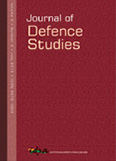Arvind Gupta, Amitav Mallik and Ajey Lele (eds), Space Security: Need for Global Convergence
The book, Space Security: Need for Global Convergence, is about organizing the commons of Outer Space. The international legal framework for Outer Space, which has been in place for the last four decades, has, time and again, affirmed that Space must be used for peaceful purposes.
- S.K. Das |
- April 2012 |
- Journal of Defence Studies




